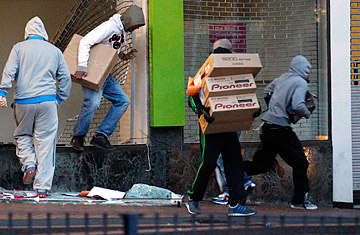
Looters carry boxes out of a home-cinema shop in central Birmingham, in central England, on Aug. 9, 2011
The morning after riots gripped its main shopping thoroughfare, parts of Ealing, northwest London, looked less like a middle-class suburb and more like a war zone. On the night of Aug. 8, a group of hooded youths ran up the street throwing trash bins while others stomped on the top of police patrol cars. Still others shattered through glass phone booths and set cars on fire, not far from the town's picturesque rows of Victorian houses. Simon Kirby, who runs Flower Haven, a small florist, says his brother phoned him at 6:30 a.m. to let him know that his shop's windows had been smashed and his floral displays ransacked. The violence sickens him, but he understands why disaffected youth — whom he thinks traveled to Ealing from elsewhere — would lash out. "If they had something to do, if they had money and jobs, they wouldn't do this," he says. "They see footballers who all have lots of money but aren't very bright, and they want to know why they don't have any."
In the three days that followed the initial riots in Tottenham, disgruntled youth across the country have shown they're ready for a riot — and whatever status and material objects their disobedience may confer on them. By 5:30 p.m. on Tuesday, mobs were disturbing the peace for the fourth consecutive evening. In Manchester, hundreds of youth — some clad in balaclavas, others in ski masks — fought running battles with police. In Salford, a nearby suburb, separate groups of hooligans looted a liquor shop and set a clothing store on fire. In Nottingham, a group of at least 30 men firebombed a police station. And in Birmingham, a hit-and-run driver killed three men who had taken to the streets to protect local shops. That unrest followed copycat lootings and violence that had already taken place in other major hubs including Bristol and Liverpool. Nationwide, police have now made more than 1,000 arrests.
Paul Bagguley, a sociologist at the University of Leeds, believes rioting will continue to spread to other cities unless police step up their intervention. The brigands hurling bricks through windows aren't doing so out of solidarity with the people of Tottenham. "They are making a rational calculation that they can go out and do this," he says. "They see on television and the Internet people looting shops, going in and walking out with new mobile phones and flat-screen TVs. And no one is stopping them." That might explain the images of one teenager calmly texting someone on her phone as she stands among looters in a computer store in Croydon or of the looters in Brixton who stood in line to try on a pair of stolen sneakers.
Bulking up the police presence — 16,000 officers policed the streets last night, compared with 6,000 the night before — did much to turn off would-be vandals. London saw relative calm for the first time since Aug. 6, though there were a few minor clashes as community vigilantes took security into their own hands. The decision to release images of rioters, culled from CCTV footage, on the London police's Flickr page and via the BBC on Tuesday afternoon has also sent a strong message that authorities — and the wider public — want to see justice served. The police's Flickr page received around 3 million hits within five hours of going live.
But arrests resulting from those photos may not come for months, if at all. And they will do little to resolve the underlying issues that are now boiling over. Racial tensions have fomented much of the anger that's being released, and that informs the deteriorating relationship between officers and the communities they police. In the past five years, the number of black and South Asian people stopped and searched by the police in the country has nearly doubled to 310,000. "Most of the time the police don't find anything," Bagguley says. "I think what we're seeing is partly a consequence of those tactics." That many of the looters come from high-crime areas that are heavily policed strains the relationship even more. The riots in Hackney on the afternoon of Aug. 8 reportedly kicked off after one of these searches.
Social scientists say it's too simplistic to make a direct connection between Britain's austerity cuts and the mob violence. But the effects of those cuts may influence idle young people. The issue, sociologists say, is not that youth are unemployed. It's that they're unoccupied — and therefore more likely to loiter on the streets and in shopping centers, and to get wrapped up in the madness of rebellion. Tottenham, for instance, is in the borough of Haringey, where the local council had to shut 8 of its 13 youth centers at the beginning of July. The centers had offered courses on everything from beauty treatments to DJing, and services ranging from sexual-health tests to exam revision. "A lot of those radicalized youth who were on the street Saturday night would have been going to those youth centers," says Clifford Scott, a senior lecturer in social psychology at the University of Liverpool. "They no longer had anywhere else to go."
As the sun set on Tuesday evening and the country braced for a fourth night of riots, the BBC rolled footage of still more disturbances, this time in Wolverhampton, a town northwest of Birmingham. Groups of youth dressed in black hoodies ran down the street and set to attacking shops. Back in Ealing, local MP Virendra Sharma walked through the town after nightfall to reassure residents that peace had returned to the community. Businesses shut at 3 p.m. Many boarded up their windows anyway.
— With reporting by Sonia Van Gilder Cooke / London and Thomas K. Grose / Ealing
